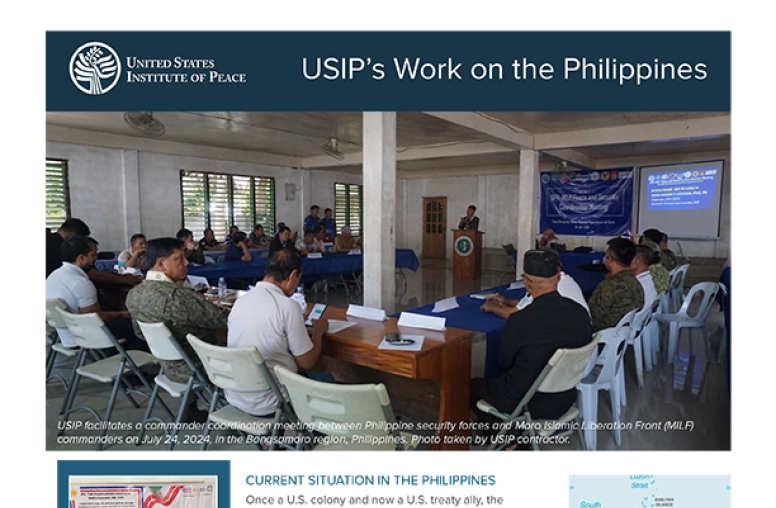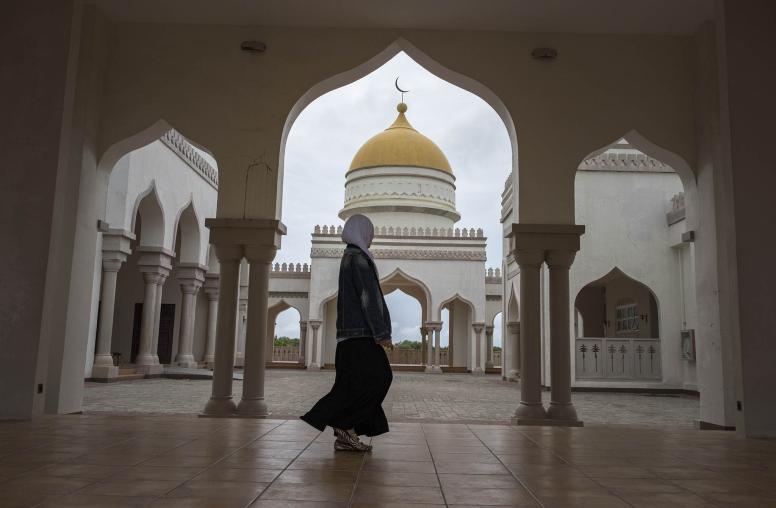Examining Local Grievances and Militant Groups in the Southern Philippines
Five years after the deadly Marawi siege, a sense of hopelessness leaves communities vulnerable.
Editor’s Note: The 2017 Marawi siege was a turning point in the trajectory of peace efforts in Mindanao, helping to rejuvenate peace talks that had largely derailed at the time. For many in Mindanao, the Marawi siege serves as a reminder of what is at stake if current peace efforts fail. In part three of this USIP editorial series examining the conflict-marred Southern Philippines, Acram Latiph explores some key lessons from the Marawi siege based on his experiences of the siege and interviews with survivors. He warns that the conditions exploited by the Islamic State group’s recruiters to lure locals into its ranks persist to this day. Bangsamoro authorities will need to do more than just address issues of poverty and marginalization. They must also address the sense of hopelessness that pervades many Bangsamoro communities. Read part one and part two in this series.
The 2017 Marawi siege was devastating for my city and its people. For five long months, Dawlah Islamiyah, known locally as the Maute-ISIS group, battled the Armed Forces of the Philippines (AFP), resulting in the displacement of more than 300,000 people. Large parts of Marawi remain uninhabitable to this day. As a result, many of the city’s residents are forced to live in camps for internally displaced persons (IDPs) almost five years since the end of the siege.

To understand the Marawi siege and draw lessons for preventing similar attacks, we must reflect on the months before and after the siege. Having lived through the siege and spoken with dozens of local survivors, I believe that it is important for Bangsamoro authorities and all the people of the Bangsamoro Autonomous Region in Muslim Mindanao (BARMM) to understand some key lessons from our experiences.
The Promise of a Better Life
For some time before the Marawi siege, it was clear that Islamic State sympathizers were operating in Mindanao. At the time, many dismissed this threat and labeled them as boys who had lost their way and been influenced by foreign ideas. The reality was more complex. These were locals who sought to exploit local grievances to recruit from local communities. The story of Abol (not his real name) and the men who regularly visited his home in the months before the siege comes to mind.
Abol, a father of nine children who could barely make ends meet, tried to hide his embarrassment. The roof of the dilapidated hut his family called home leaked profusely under the torrential rain. He asked his two guests again to move away from the windows and avoid getting wet. For almost two hours, the two men, dressed in only black, tried to persuade Abol to join Dawlah Islamiyah. This was the third time the guests had visited Abol’s home. One of the men told Abol that he must wage jihad and be part of the Islamic caliphate because it is his duty as a Muslim. Finally, Abol relented. As he believed he was past his prime and had a lot of farm work to complete, he suggested the men take his eldest son, aged 16, to join their effort. Then, invoking a thanksgiving prayer, the guests gave Abol money before leaving. The following day, they returned to take Abol’s son to their training camps in the dense jungles to the east and south of Lake Lanao.
Abol’s story is not unique. I heard similar stories time and again from those living in poor, isolated and rural communities. The recruitment successes of Dawlah Islamiyah can be attributed to its relentless approach of luring prospective members with the financial assistance it offered desperate people. Many recalled how Dawlah Islamiyah recruiters would repeat the slogan: “Dawlah Islamiyah will establish an Islamic state; if we succeed, everyone will have a better life; if we fail, we will leave this miserable life and be assured a great place in paradise. Either way, we win.” It reveals another factor often highlighted by local communities: a sense of hopelessness. It was a feeling the community seemed to share with the recruiters.
End of a Siege, But Militant Threat Remains
From the beginning, the Marawi siege was destined to fail. Dawlah Islamiyah was no match for the full might of the AFP. It is estimated that almost 1,000 militants were killed in the siege with many, including Dawlah Islamiyah’s leaders, fighting to their deaths. The militants were willing to sacrifice their lives if they felt that doing so would benefit their cause and bring it media attention. While individuals looked to sacrifice themselves in this single operation, most did so believing their death would sow the seeds for future insurrections. Those militants who managed to escape Marawi returned to the thick jungles of Lanao del Sur where they continue their struggle as a guerrilla war.
The false narrative of better lives and a brighter future for those who join Dawlah Islamiyah still has some traction in the minds of many people, especially among the poor and marginalized. This belief is further strengthened by the financial support and other aid that is often offered to the families of those who join Dawlah Islamiyah. Moreover, Dawlah Islamiyah recruiters have distributed propaganda materials — such as “Dabiq” magazine, video clips and audio speeches produced by the Islamic State group — in remote areas. These materials are intended to showcase the good life enjoyed by Islamic State communities around the world, a life that the local communities could also enjoy if Dawlah Islamiyah succeeded.
The threat Dawlah Islamiyah poses to Lanao del Sur and the BARMM more broadly remains. Evidence from interviews with former members of Dawlah Islamiyah reveals that they live a life of hardship and poverty. They are marginalized and excluded from the mainstream community and resentful of governments that seem distant.
Lanao del Sur, the home base of Dawlah Islamiyah, is the poorest province in the Philippines. Opportunities for advancement are scarce. Many residents share a sense of hopelessness. So, when someone comes along offering money, an opportunity for a better future and a chance to make a difference, it is very tempting for potential recruits.
For all their religious rhetoric, violent extremists in Mindanao understand that appealing to livelihood, security and a sense of hopelessness is often the most powerful recruitment tool. Those seeking to counter Dawlah Islamiyah’s appeal must make the lives of prospective recruits worth living, not only in a practical sense, but also in a psychological and social sense.
Lessons for Peacebuilding
Efforts to remedy dire social conditions need to reflect the desires of local communities. For example, livelihood programs must be based on the needs of the people. After the Marawi siege, many NGOs implemented intervention programs that were too often based on the ideas of program designers located thousands of miles away and not on the actual needs of the affected communities. The result has been ineffective initiatives that have done more to increase resentment than remedy it.
Practical efforts to improve the socioeconomic status of locals need to be combined with programs that encourage a culture of peace. Too often, peace education is limited to schools and universities when in fact it needs to reach rural areas, out-of-school youth and other marginalized groups that need it most.
Religious leaders, too, must help address violent extremism in local communities, especially by dispelling the belief among extremists that their death in war assures them a place in paradise. Such beliefs fuel a culture of violent sacrifice that is readily exploited by militant groups. If religious leaders can invalidate this belief, then a major source of strength among violent extremists will vanish.
The road to the Marawi siege was built over many years thanks to endemic poverty, failed governance and a lack of educational and work opportunities. Paving new pathways away from a life of violence and addressing the sense of hopelessness that besets many in the community will likely take just as long. That effort will be worth the investment — not just for the people of Bangsamoro, but for the Philippines as a whole.
Acram Latiph is the executive director of the Institute for Peace and Development in Mindanao at Mindanao State University – Marawi.



